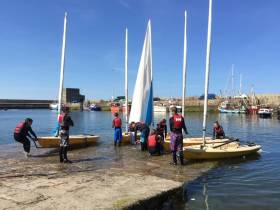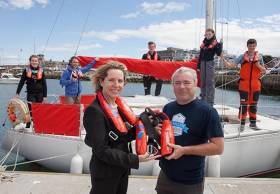Displaying items by tag: Irish Youth Sailing Club
#Crime - A sail training boat owned by the Irish Youth Sailing Club is among those vandalised in an incident at Dun Laoghaire’s West Pier over the weekend, as TheJournal.ie reports.
The RIB, which was slashed and had its outboard engine removed, was one of three vessels damaged in the attack, the aftermath of which was discovered on Sunday morning (7 May).
Also affected were the Dun Laoghaire Sea Scouts, who lost an engine to theft, while a third engine was stolen from a yacht in the nearby inner harbour — the latest incident in what’s being described as a rise in thefts and vandalism in the area.
Kyron O’Gorman of the IYSC says a replacement training RIB could set the club back at least €7,000.
TheJournal.ie has more on the story HERE.
Bord Iascaigh Mhara Promote Safety at Sea to Young Sailors from the Irish Youth Sailing Club
Bord Iascaigh Mhara (BIM), the Irish Sea Fisheries Board were delighted to present the Irish Youth Sailing Club with a set of compact Personal Flotation Devices (PFDs) on Monday 11th July at the West Pier, Dun Laoghaire.
Building on BIM’s recent ‘Live to Tell the Tale – Always Wear your Lifejacket’ campaign aimed at increasing awareness for safety at sea for the commercial fishing sector; the agency is also keen to promote safety to our young people as Tara McCarthy, BIM CEO explains; ‘Safety at Sea is a key priority for BIM and our commercial fishing sector. We at BIM want it to be a priority for all who go to sea. Partnering with the Irish Youth Sailing Club and their Principle Kyron O’Gorman, I am delighted to be here today to present eight of the latest compact lifejackets to a young crew and their Skipper Eugeen McCann. Instilling a safety at sea culture from a young age will help to save lives now and into the future. Education and awareness is key and the inclusion of personal locator beacons in these lifejackets will enable the emergency services to locate a person overboard in a matter of minutes. Congratulations to Kyron and his team, they have trained and encouraged many young people to learn a valuable skill and this investment will result in talented safety focused mariners in the future’
Irish Youth Sailing Club was set up by Kyron O’Gorman for children from 10 years old from non sailing backgrounds. The club is running for 30 years and provides children with basic training in sailing, powerboating, kayaking and VHF, First Aid and Navigation.
The club was recently presented with a Yacht and in partnership with Gearoid O’Rinn from the Sea Scouts, the new Venture Yacht will open the door to older teenage members with further training including a Day Skipper or Yacht Master qualification.
Kyron O’Gorman, Principle of Irish Youth Sailing Club and Officer in Charge in the Irish Coast Guard from Dublin to Bray expressed his gratitude to BIM and local supporters; ‘Thanks to the incredible support from BIM, private Sailors and our Commercial marine sector, we now have a programme in place that is a step up for our more senior teenagers. We are delighted to have the best PFD’s currently available on the market and along with BIM safety training for our crew, we will be fully prepared for our new venture at sea’






























































